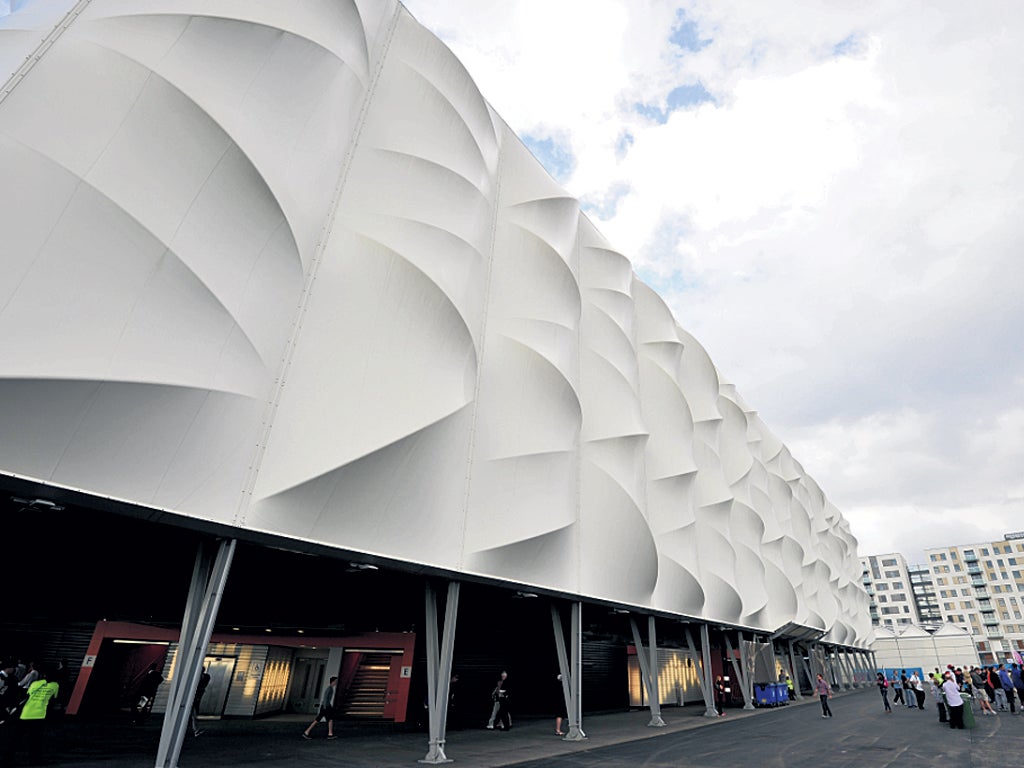Will London's reusable 'tent' turn the Games into a circus?
Basketball venue will be dismantled after 2012 and could see action at the Rio Olympics... and beyond

It may not be the most eye-catching of London's Olympic venues – indeed, it has been likened to a giant bunion pad – but the jagged white tarpaulin that is the 2012 Basketball Arena might well become a unique part of Olympic Games history.
The 12,000-seat arena is an entirely temporary construction and, before the first dunk of the Games of the XXX Olympiad has been slammed, officials at Rio 2016 have expressed an interest in taking over the entire structure and reassembling it in Brazil.
The temporary arena is still owned by its designers and manufacturers, Barr Construction in Paisley, Scotland, and is merely being leased to the Games. The company sees no reason why its arena could not be taken first to Rio de Janeiro, then on to Madrid, Baku, Doha, Tokyo or wherever the 2020 Games take place – the first, possibly, of many big tops in a travelling Olympic circus.
London 2012 already marks a sea change in Olympic thinking. Greece, amazingly, is still paying for its 2004 Games. No future competition is likely to be underwritten by the kind of blank cheque that backed Beijing in 2008, with authorities there still struggling to find uses for all the extraordinary stadia. "Affordable" and "futureproof" are the new Olympic buzzwords, and the basketball arena is certainly both of those.
A spokesman for Barr Construction said the company had "spoken to a number of groups about the use of the stadium" but that Rio was its "preferred option". At the moment the company is committed only to dismantling the structure after the Paralympic Games, when it will host wheelchair basketball and rugby. Its role in Rio may not be limited to basketball. "They could use it for anything in theory," the spokesman said. "There may even be a use for it at the 2014 World Cup [also being held in Brazil]. It is fundamentally a large space. You could get anything in it. It has been designed to be put up easily and taken down easily. It is reusable many times. In theory, it could be taken anywhere."
The structure, which is 108ft (33m) high and 377ft long, took 15 months to build first time round – but Barr expects the process will be speeded up in future. At the end of the London Games, the Olympic Delivery Authority (ODA) will also find itself in possession of around 27,000 seats.
Of these, 12,000 will come from the basketball arena and a further 15,000 will be removed from the Aquatic Centre, when its capacity is reduced from 17,500 to 2,500. ODA chairman John Armitt has indicated that many thousands of these may find their way to Brazil.
Other temporary 2012 venues include the beach volleyball at Horse Guards Parade in Westminster and the 5,000-seat £25m water polo arena, built by London-based events company ES Group. In a case of water polo coming home, before London won the bid to host the games, the company was originally based in what is now the Olympic Park, and has since moved to nearby Docklands.
In the meantime, Olympic authorities have appointed civil engineering firm BAM Nuttall to transform the Olympic Park after the Games – work that is expected to take up to 18 months.
It will clear temporary venues and roadways and install new cycle and pedestrian paths as well as a mountain-bike trail and outdoor cycle circuit at the Velopark. Many sections will be open to the public from July 2013.
Subscribe to Independent Premium to bookmark this article
Want to bookmark your favourite articles and stories to read or reference later? Start your Independent Premium subscription today.

Join our commenting forum
Join thought-provoking conversations, follow other Independent readers and see their replies